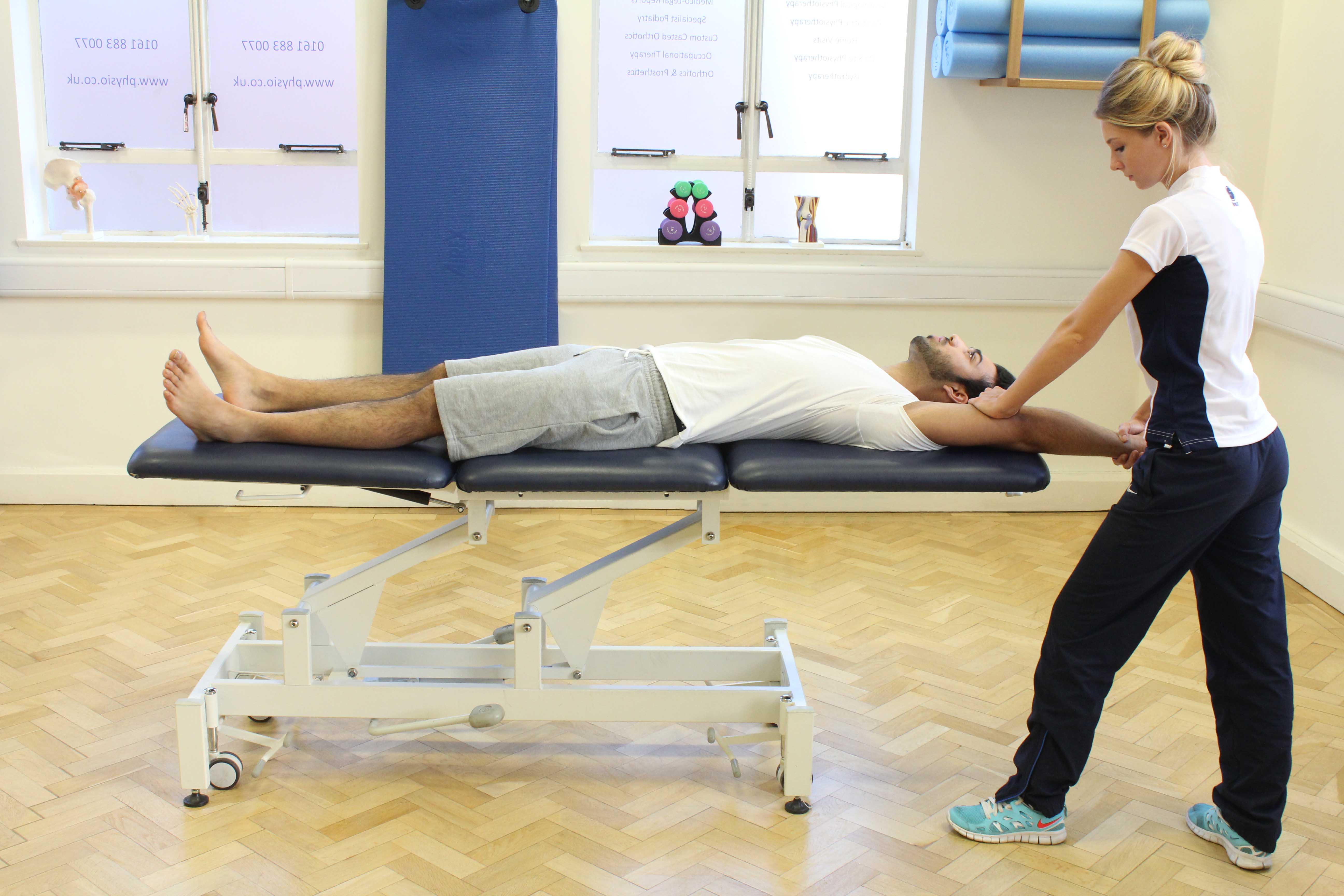There are 4 types of surgery performed depending on the extent and severity of your injury. These are:
- Shoulder Arthroplasty – the humeral head is cut away and replaced with a metal ball and a long stem which is inserted and cemented inside your humerus. The glenoid surface is replaced and screwed into the scapula.
- Reverse Shoulder Arthroplasty – here the joint is reversed and the glenoid is replaced with a ball like surface and the humerus replaced with a concave, glenoid like, surface. This is usually performed when there is a deficient rotator cuff.
- Hemiarthroplasty – here only the humeral head is replaced. A prosthetic metal implant is placed into the humerus forming the humeral head
- Joint Surface Replacement – only the surface of the humerus is replaced. Usually performed when the cause is arthritic.
 Above: Stretches of the shoulder joint by an experienced therapist
Above: Stretches of the shoulder joint by an experienced therapistPhysiotherapy before Shoulder Replacement Surgery
Physiotherapy prior to shoulder replacement is a useful and recommended intervention. It will help to reduce your current symptoms, provide a solid platform for post surgical rehabilitation and accelerate your rehab period. Treatments offered include:
|
Acute management of symptoms |
- Strengthening surrounding musculature
- Massage and stretching
- Advice on surgery and post-surgical management
Symptoms following Shoulder Replacement Surgery
Following shoulder replacement, your shoulder will be placed in a protective sling for 4-6 weeks to help protect the new shoulder, aid recovery and maximise rehab potential. Common symptoms following shoulder replacement surgery include:
- Pain
- Swelling
- Bruising
Physiotherapy after Shoulder Replacement Surgery
Following shoulder replacement surgery a well planned physiotherapy programme designed with Physio.co.uk is critical for the success of the operation. Physio.co.uk will provide a thorough assessment, including explanation of treatment, as well as design a personal rehabilitation programme. Treatment will initially focus on acute management following surgery and progress on to regaining strength and function.
Weeks 1-3
Initial treatment with Physio.co.uk will concentrate on minimising post operative complication, reducing acute symptoms and the initiation of movement. Treatment will include:
- Cryotherapy
- Pain Management
- Sling use – advice and exercises while in sling
- Elbow, wrist and hand range of movement and strengthening exercises to prevent stiffness and muscle atrophy (wasting away of the muscles)
- Passive and active assisted range of movement
- Isometric strengthening
- Scapula stabilising
- Postural awareness
- Wound management
Weeks 4-6
Following week 4 your sling will be removed and you will be encouraged to commence increased active range of motion and strengthening exercises. Physio.co.uk will develop your programme with specific attention to personal and occupational requirements. Treatment will include:
- Increased passive range of movement to full range
- Begin active range of movement
- Scapular Stabilising
- Soft tissue massage
- Capsule stretching
- Strengthening
- Closed chain activities
- Proprioceptive training
- Scar management
Weeks 7-12
Following week 7 Physio.co.uk will focus on a continuation and progression of exercises. Rehabilitation will include specific exercises needed to perform functional activities and be directed to attaining full range of movement, improving muscular strength and endurance. Treatment will comprise of:
- Full active range of movement
- Stretching
- Soft tissue massage
- Shoulder and scapular strength through range
- Closed and open chain activities
- Muscular endurance
- Breakdown of functional activities into manageable components
- Increased Proprioceptive training
Weeks 12+
Following week 12, your movement and strength will be greatly improved and will be equal or close to your pre-operative state. Full recovery can take up to 12 months and so Physio.co.uk will provide a comprehensive long term rehabilitation programme for you to follow with a clear focus on maximising functional use of your arm. Treatment will include:
- Attainment of full range of movement
- Advanced strengthening throughout range
- Advanced proprioceptive exercises
- Functional training
- Long term management
Summary
Shoulder replacement surgery, or shoulder arthroplasty, is a surgical procedure performed to replace the shoulder joint. Usually carried out due to severe arthritic changes it can have a profound effect on returning functional, pain free use of your arm. After undergoing this surgery it is essential to undergo physiotherapy to help return functional use of your arm. Physio.co.uk will provide a comprehensive rehabilitation programme to ensure the return of a strong pain free arm and a return to sporting and occupational activity. Call Physio.co.uk now on 0330 088 7800 for more information or to book an appointment please contact us.

 0330 088 7800
0330 088 7800





































